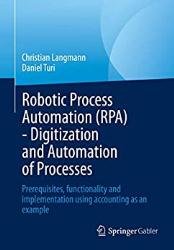Robotic Process Automation (RPA) - Digitization and Automation of Processes
- Добавил: literator
- Дата: 19-01-2023, 04:50
- Комментариев: 0
 Название: Robotic Process Automation (RPA) - Digitization and Automation of Processes
Название: Robotic Process Automation (RPA) - Digitization and Automation of ProcessesАвтор: Christian Langmann, Daniel Turi
Издательство: Springer
Год: 2022
Страниц: 143
Язык: английский
Формат: pdf (true), epub
Размер: 19.2 MB
The use of Robotic Process Automation (RPA) can release considerable efficiency potential for organizations and thus create new opportunities for employees without having to set up costly (IT) projects. The increasing response from practitioners and the high growth expectations for the RPA market in the coming years are therefore not surprising. However, the necessary prerequisites, functionalities and steps for the introduction of this new technology are more extensive than one might initially suspect. Freely available literature and documentation on this are unfortunately usually superficial, not very objective or incomplete. For this reason, we decided to systematize our many years of experience with the use of RPA software and to document it in an easily understandable and practical manner.
The new or further development of numerous digitization technologies in recent years has contributed to the evolution of RPA into so-called Intelligent Process Automation (IPA). IPA combines RPA with other digitization technologies in order to give classic software robots more advanced (cognitive) capabilities. The ability to process complex data structures should make the connection clear. Today, RPA is dependent on structured data. Structured data (e.g. numbers, tables) are characterized by the fact that structuring information is available for them, by which the data is defined. This so-called metadata provides information about the format, permitted values, or semantic meaning of the data, among other things. In the case of semi-structured data (e.g. e-mail), the metadata is only available for part of the data because only individual components are structured. In the case of unstructured data (e.g. video, images), on the other hand, the structured information is completely missing or unrecognizable. By using additional technologies such as optical character recognition (OCR) or natural language processing (NLP), robots are now able to capture, understand and process unstructured and thus complex data such as texts.
However, the link with digitization technologies does not only give robots the ability to process unstructured data. Rather, software robots are being equipped with such cognitive capabilities through Artificial Intelligence (AI) technologies that they can perform even more complex analyses and make cognitive decisions or imitate human decisions.
According to Ng KKH, Chen C-H, Lee CKM "A systematic literature review on intelligent automation", the evolution from RPA to intelligent process automation can be divided into different stages. According to this, IPA is only the first stage of intelligent process automation. IPA still needs interactions with human users to make correct decisions if the decision situations are not based on clear if-then rules or already known through sufficient training. In the second stage, Ng et al. refer to the stage as Augmented Intelligent Process Automation, the cognitive abilities of robots improve to increasingly make their own decisions in the context of process automation. The robots learn to do this by observing or processing human decisions that users make. Level four, full automation (autonomous agents), can handle highly complex processes independently. Full automation is self-managing, self-learning, and self-healing when errors occur. It, therefore, no longer requires any intervention by the user.
Contents:
1. Introduction
2. Basics of Robotic Process Automation (RPA)
3. Introduction of RPA in Financial and Management Accounting
4. From RPA to IPA: How Software Robots Are Becoming Smarter
5. RPA in Practice: Results of an Empirical Study
6. Application Examples for RPA in Financial and Management Accounting
7. Conclusion and Outlook
Скачать Robotic Process Automation (RPA) - Digitization and Automation of Processes
Внимание
Уважаемый посетитель, Вы зашли на сайт как незарегистрированный пользователь.
Мы рекомендуем Вам зарегистрироваться либо войти на сайт под своим именем.
Уважаемый посетитель, Вы зашли на сайт как незарегистрированный пользователь.
Мы рекомендуем Вам зарегистрироваться либо войти на сайт под своим именем.
Информация
Посетители, находящиеся в группе Гости, не могут оставлять комментарии к данной публикации.
Посетители, находящиеся в группе Гости, не могут оставлять комментарии к данной публикации.
